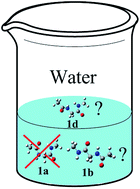Conformational preferences of Ac-Gly-NHMe in solution†
Abstract
The conformational behaviour of Ac-Gly-NHMe in nonpolar, polar and polar protic solutions was systematically studied in this work by theoretical calculations and experimental infrared and 1H NMR spectroscopies. Ac-Gly-NHMe prefers a gauche conformer with a strong seven-membered intramolecular hydrogen bond for the isolated compound and in nonpolar solvents, but such preference changes in polar and polar protic solvents. Elucidation of Ac-Gly-NHMe preferences was also supported by studying the conformers of its CF3-C(O)-Gly-NHMe and Ac-Gly-N(Me)2 derivatives in solution.


 Please wait while we load your content...
Please wait while we load your content...